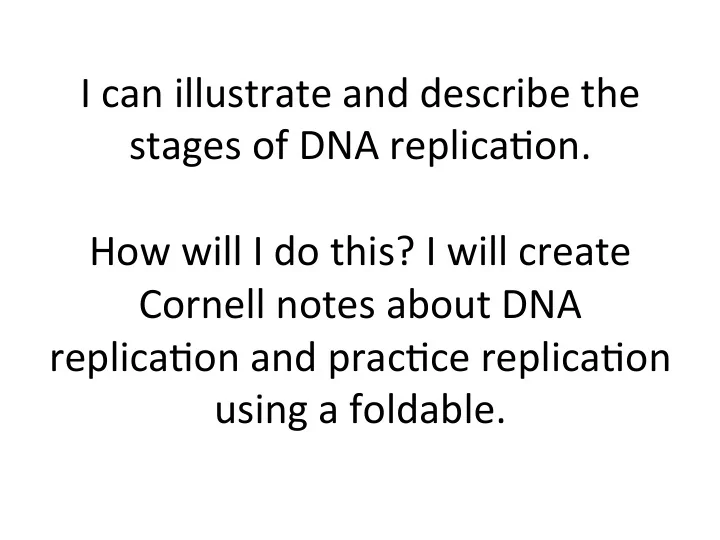

I ¡can ¡illustrate ¡and ¡describe ¡the ¡ stages ¡of ¡DNA ¡replica7on. ¡ ¡ How ¡will ¡I ¡do ¡this? ¡I ¡will ¡create ¡ Cornell ¡notes ¡about ¡DNA ¡ replica7on ¡and ¡prac7ce ¡replica7on ¡ using ¡a ¡foldable. ¡
-‑Before ¡a ¡cell ¡ divides, ¡it ¡copies ¡ its ¡DNA ¡in ¡a ¡ copying ¡process ¡ called ¡ replica(on . ¡ ¡ -‑Why? ¡To ¡make ¡ iden7cal ¡DNA ¡ ¡
DNA ¡replica(on ¡ begins ¡at ¡a ¡single ¡point ¡in ¡the ¡ sequence ¡and ¡proceeds, ¡in ¡two ¡direc7ons, ¡un7l ¡the ¡ en7re ¡strand ¡is ¡replicated. ¡ ¡ This ¡takes ¡place ¡in ¡the ¡nucleus. ¡
Where ¡does ¡DNA ¡replica(on ¡take ¡ place? ¡ Why ¡must ¡DNA ¡be ¡replicated? ¡
¡ -‑A ¡number ¡of ¡different ¡enzymes ¡(helicase, ¡DNA ¡ polymerase, ¡DNA ¡ligase, ¡primase) ¡are ¡used ¡to ¡match ¡both ¡ sides ¡of ¡the ¡DNA ¡ladder ¡to ¡new ¡base ¡pairs ¡in ¡a ¡5’ ¡ à ¡3’ ¡ direc7on ¡ -‑Result? ¡2 ¡NEW ¡DNA ¡molecules(each ¡with ¡1 ¡old/1 ¡new ¡ strand) ¡
-‑A ¡special ¡enzyme ¡(helicase) ¡is ¡used ¡to ¡ unzip ¡the ¡DNA ¡molecule. ¡ -‑DNA ¡Polymerase ¡binds ¡bases ¡to ¡the ¡new ¡ strand. ¡
-‑Each ¡strand ¡of ¡the ¡DNA ¡double ¡helix ¡has ¡all ¡of ¡the ¡ informa7on ¡needed ¡to ¡recreate ¡the ¡other ¡half ¡(base ¡ pairing ¡rules). ¡ -‑Because ¡each ¡strand ¡can ¡be ¡used ¡to ¡make ¡the ¡other ¡ strand, ¡the ¡strands ¡are ¡said ¡to ¡be ¡ complementary . ¡
What ¡does ¡the ¡word ¡ “complementary” ¡mean ¡when ¡ referring ¡to ¡DNA ¡strands? ¡ ¡
Semi-‑conserva(ve ¡model: ¡ each ¡strand ¡aUer ¡ DNA ¡replica7on ¡is ¡made ¡from ¡half ¡the ¡ original(parent) ¡strand ¡and ¡half ¡new ¡ OLD ¡
The ¡complementary ¡strand ¡for ¡ AGGCTAAGTCGGTA ¡is ¡ TCCGATTCAGCCAT… ¡ ¡ ¡ ¡ ¡ ¡ ¡ ¡ ¡ ¡ ¡ ¡ ¡ ¡ ¡ ¡ ¡ ¡ ¡ ¡ ¡ ¡ ¡ ¡ ¡ ¡ ¡ ¡ ¡ ¡
Your ¡turn… ¡ ¡ What ¡is ¡the ¡complementary ¡strand ¡for ¡ the ¡following: ¡ ¡ CGGAAT ¡ GCCTTA ¡
How ¡does ¡the ¡structure ¡of ¡DNA ¡ make ¡its ¡replica(on ¡easy? ¡
DNA ¡Replica(on ¡Foldable ¡ 1. Now ¡fold ¡the ¡two ¡sides ¡in ¡to ¡meet ¡in ¡the ¡ What ¡ middle(hamburger ¡style). ¡ you’re ¡ given ¡ 2. You ¡have ¡been ¡given ¡one ¡side ¡of ¡the ¡ ORIGINAL/PARENT ¡strand. ¡Note: ¡we ¡have ¡ taken ¡only ¡one ¡side ¡of ¡DNA ¡from ¡AFTER ¡the ¡ replica7on ¡fork. ¡On ¡the ¡opposite ¡side, ¡draw ¡ and ¡replicate ¡the ¡complementary ¡strand. ¡ What ¡ 3. Open ¡your ¡edges, ¡and ¡complete ¡the ¡DNA ¡ you’re ¡ word ¡search. ¡ ¡ making ¡ ¡
STUDENT ¡COPY ¡
I ¡can ¡illustrate ¡and ¡describe ¡the ¡ stages ¡of ¡DNA ¡replica7on. ¡ ¡ How ¡will ¡I ¡do ¡this? ¡I ¡will ¡create ¡ Cornell ¡notes ¡about ¡DNA ¡ replica7on ¡and ¡prac7ce ¡replica7on ¡ using ¡a ¡foldable. ¡
DNA ¡Replica7on ¡ ¡ ¡Name:____________________ ¡ -‑Before ¡a ¡cell ¡ divides, ¡it ¡ ___________ ¡its ¡ DNA ¡in ¡a ¡copying ¡ process ¡called ¡ replica(on . ¡ ¡ -‑Why? ¡To ¡make ¡ __________DNA ¡ ¡
DNA ¡replica(on ¡ begins ¡at ¡a ¡single ¡point ¡in ¡the ¡ sequence ¡and ¡proceeds, ¡in ¡two ¡direc7ons, ¡un7l ¡the ¡ en7re ¡strand ¡is ¡replicated. ¡ ¡ This ¡takes ¡place ¡in ¡the ¡ ¡ ¡ ¡ ¡ ¡ ¡ ¡ ¡ ¡ ¡ ¡ ¡ ¡ ¡ ¡ ¡ ¡ ¡ ¡ ¡ ¡ ¡ ¡ ¡. ¡
-‑A ¡number ¡of ¡different ¡enzymes ¡are ¡used ¡to ¡match ¡both ¡ sides ¡of ¡the ¡DNA ¡ladder ¡to ¡new ¡base ¡pairs ¡ -‑Result?____NEW ¡DNA ¡molecules(each ¡with ¡1 ¡_____/1 ¡ _____ ¡strand) ¡
-‑A ¡special ¡enzyme ¡is ¡used ¡to ¡unzip ¡the ¡DNA ¡ molecule. ¡ -‑Another ¡enzyme, ¡DNA ¡__________ ¡binds ¡ bases ¡to ¡the ¡new ¡strand. ¡
-‑Each ¡strand ¡of ¡the ¡DNA ¡double ¡helix ¡has ¡all ¡of ¡the ¡ informa7on ¡needed ¡to ¡recreate ¡the ¡other ¡half ¡(base ¡ pairing ¡rules). ¡ -‑Because ¡each ¡strand ¡can ¡be ¡used ¡to ¡make ¡the ¡other ¡ strand, ¡the ¡strands ¡are ¡said ¡to ¡be ¡ ________________ . ¡
___________________ ¡model: ¡ each ¡strand ¡ aUer ¡DNA ¡replica7on ¡is ¡made ¡from ¡half ¡the ¡ ___________(parent) ¡strand ¡and ¡half ¡_______ ¡ OLD ¡
The ¡complementary ¡strand ¡for ¡ AGGCTAAGTCGGTA ¡is ¡ TCCGATTCAGCCAT… ¡ ¡ ¡ ¡ ¡ ¡ ¡ ¡ ¡ ¡ ¡ ¡ ¡ ¡ ¡ ¡ ¡ ¡ ¡ ¡ ¡ ¡ ¡ ¡ ¡ ¡ ¡ ¡ ¡ ¡
Your ¡turn… ¡ ¡ What ¡is ¡the ¡complementary ¡strand ¡for ¡ the ¡following: ¡ ¡ C ¡ ¡G ¡ ¡G ¡ ¡A ¡ ¡A ¡ ¡T ¡
DNA ¡Replica(on ¡Foldable ¡ 1. Now ¡fold ¡the ¡two ¡sides ¡in ¡to ¡meet ¡in ¡the ¡ middle(hamburger ¡style). ¡ 2. Glue ¡your ¡word ¡search ¡on ¡the ¡back ¡ ¡ ¡ ¡ ¡ ¡ ¡ What ¡ and ¡let ¡dry. ¡ you’re ¡ given ¡ 3. You ¡have ¡been ¡given ¡one ¡side ¡of ¡the ¡ ORIGINAL/PARENT ¡strand. ¡Note: ¡we ¡have ¡ taken ¡only ¡one ¡side ¡of ¡DNA ¡from ¡AFTER ¡ the ¡replica7on ¡fork. ¡On ¡the ¡opposite ¡side, ¡ draw ¡and ¡replicate ¡the ¡complementary ¡ What ¡ you’re ¡ strand. ¡ making ¡ 4. Open ¡your ¡edges. ¡Follow ¡my ¡direc7ons ¡ for ¡the ¡inside. ¡ 5. When ¡1-‑4 ¡are ¡done, ¡complete ¡the ¡ ques7ons ¡and ¡THEN ¡find ¡the ¡words ¡on ¡ back. ¡
BELL ¡WORK: ¡Label ¡your ¡paper ¡1-‑7. ¡ Match ¡the ¡following ¡with ¡the ¡correct ¡part ¡ • A. ¡Adenine ¡ T • B. ¡Base ¡Pair ¡ G • C. ¡Cytosine ¡ • D. ¡Deoxyribose ¡ sugar/Phosphate ¡ • E. ¡New ¡Strand ¡ • F. ¡Replica7on ¡Fork ¡ • G. ¡Nucleo7de ¡
Recommend
More recommend